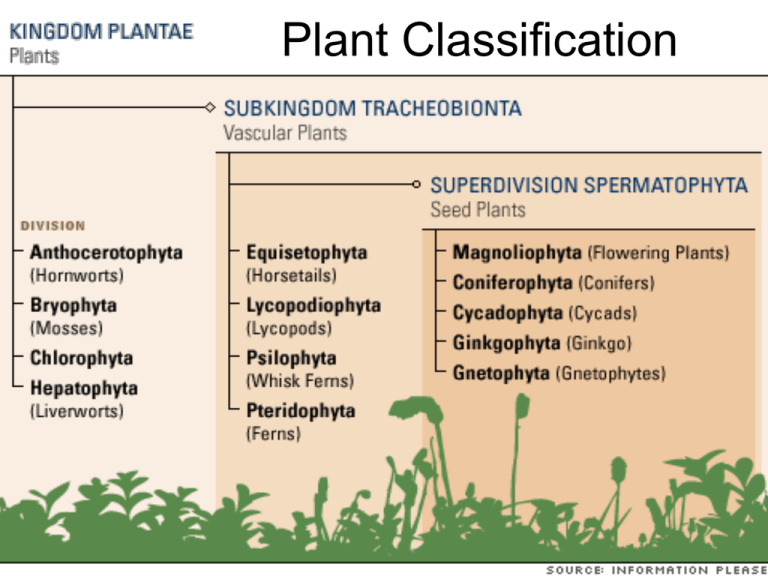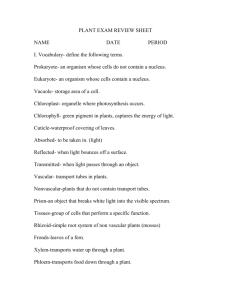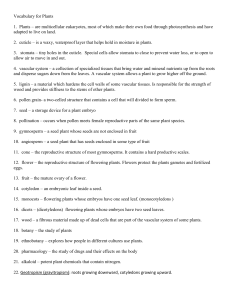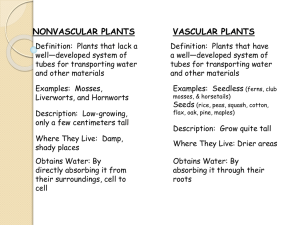Plant Classification
advertisement

Plant Classification Group 1: Seedless, Nonvascular Plants • Live in moist environments • Liverworts • Hornworts • Mosses Mosses • Nonvascular, seedless • Grow low to ground to retain moisture • Lack true leaves – Leaf-like structures only 1 cell thick • Rhizoids anchor into soil • Early inhabitant of new ecosystems (succession) Group 2: Seedless, Vascular Plants • Vascular system allows nutrient transport to greater heights • Club mosses • Horsetails • Ferns Ferns • Seedless, vascular plants – Vascular: allows taller growth • Rhizoids: underground stems draw nutrients • Fronds: leaves uncurl – sporangia on underside • Sori: clusters of sporangia Group 3: Seed producing, Vascular Plants • Gymnosperms – Cycads – Ginko – Conifers • Angiosperms Group 3: Seed producing, Vascular Plants • 1) Seed plants don’t depend on water to reproduce – Pollen (contains sperm) combines with egg – Egg hardens into a seed • 2) Nourishment and protection – Nourish: Nutrients inside seed for the embryo – Protection: Hard shell • 3) Allow dispersal – Carried by wind, water, animals Group 3: Seed producing, Vascular Plants • Type 1: Gymnosperms • Seeds not enclosed in a fruit – produced inside cones • Cone = reproductive structure • Male cones: produce pollen • Female cones: produce eggs and seeds Group 3: Seed producing, Vascular Plants • Gymosperm example: Conifers – Cone plants – Needle-like leaves – Common to lumber industry – Evergreen, Pine, Redwood, Cedar Group 3: Seed producing, Vascular Plants • Type 2: Angiosperms (flowering plants) • Flower = reproductive structure – Protects gamete and fertilized eggs • Seeds enclosed in a fruit – Fruit: Plant ovary – Often attract animals to disperse the seeds inside Fruit Production • In the seed – Embryo – Food supply • Surrounding ovary grows into a fruit • Fruit attracts animals to eat and spread the seeds Fruit seeds in fox droppings Angiosperm types (flowering plants) • 2 groups: Monocots and Dicots (based on seed type) • Cotyledon: embryonic leaf • Monocots: embryo with 1 seed leaf • Dicots: embryo with 2 seed leaves Monocots vs. Dicots Angiosperm Life Spans • Three Life Span Types: • Annuals – 1 year: Mature…produce seeds…die • Biennials – 1st year: produces short stem, low growth leaves, food reserves – 2nd year: taller stem, leaves, flowers, seeds • Perennials – Live for more than 2 years Flowers • Reproductive structure of flowering plants • Sepals – outer ring of leaves – protection • Petals – Inner ring of leaves – Brightly colored to attract pollinators • Open petals & sepals reveal male and female structures Flowers • Female Carpel – Inner most part – Ovary: within the base (female gametophyte) – Style: long stalk – Stigma: sticky tip, collects pollen • Male Stamen – Surrounds carpel – Filaments: long stalks – Anther: produces pollen (male gametophyte)






